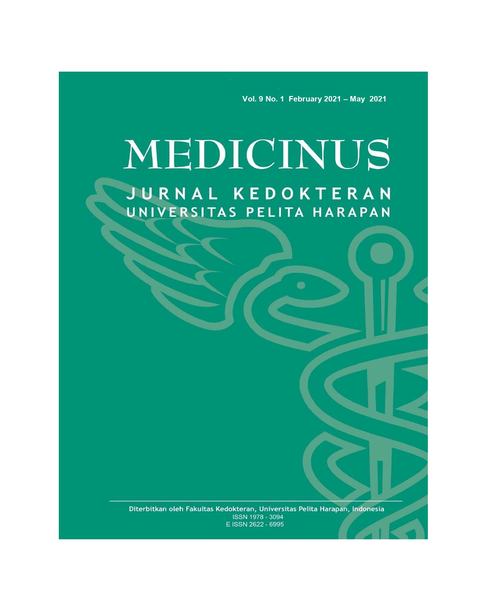Association Between Cigarette Smoking And Cognitive Function In Stroke Patients Of Siloam Lippo Karawaci Hospital
DOI:
https://doi.org/10.19166/med.v9i1.4191Keywords:
Stroke, cognitive function, cigarette smoking, MoCA-INAAbstract
Stroke is cerebrovascular disease, causing deterioration of brain function as a result of cerebral blood flow disruption. Stroke is the third leading cause of death in the world and is considered an important cause of long-term disability and cognitive impairment. Risk factors of stroke are further divided into unmodifiable risk factors and modifiable risk factors, with one of the most common modifiable risk factors of stroke, is cigarette smoking. Besides being one of the risk factors that cause stroke, cigarette smoking is believed to have a role in cognitive impairment. This study aims to obtain information regarding the association between cigarette smoking and cognitive function in stroke patients of Siloam Lippo Karawaci Hospital. This research is an unpaired comparative analytical study with a cross-sectional design. Data sampling was taken by consecutive sampling on 56 stroke patients of Siloam Lippo Karawaci Hospital. Cognitive function was made based on the Montreal Cognitive Assessment version Indonesia (MoCA-INA). All data were analyzed by Chi-Square test using SPSS version 25 and the result is considered significant if the p-value < 0,05. From the result of this study. There is a significant association between cigarette smoking and cognitive function (p-value 0,004 and OR 5,343).
References
1. World Health Organization. WHO global report on trends in the prevalence of tobacco smoking 2015. Geneva; 2015. 1-359 p.
2. Balitbang, Indonesia KKR. Riskesdas 2018. 2018.
3. Center for Disease Control. GATS 2 Global Adult Tobacco Survey Fact Sheet, India, 2016-17. [Internet]. 2016 [cited 2018 Nov 1]. Available from: http://www.who.int/tobacco/surveillance/survey/gats/GATS_India_2016-17_FactSheet.pdf?ua=1
4. World Health Organization SEARO. GATS: Indonesia global adult tobacco survey: Indonesia report 2011 collaborating organizations. Kosen S, editor. Jakarta: World Health Organization SEARO; 2012. 1-182 p.
5. Irianti S, Herman MJ, Prasetyoputra P, Al E. Pokok-pokok hasil riset kesehatan dasar provinsi banten 2013. 1st ed. Musadad A, Inswiasri, editors. Jakarta: Lembaga Penerbitan Badan Litbangkes; 2014.
6. Head E. Oxidative damage and cognitive dysfunction: antioxidant treatments to promote healthy brain aging. Neurochem Res [Internet]. 2009 Apr [cited 2021 Jul 8];34(4):670-8.
https://doi.org/10.1007/s11064-008-9808-4
7. Huadong Z, Deng J, Jingcheng LI, Yanjiang W, Meng Z, Hongbo HE. Study of the relationship between cigarette smoking, alcohol drinking, and cognitive impairment among elderly people in China. Age Ageing. 2003 Mar;32(2):205-10. https://doi.org/10.1093/ageing/32.2.205
8. Dobson R. Long-term smoking contributes to cognitive decline. BMJ Br Med J. 2004;329(7478):1306.
https://doi.org/10.1136/bmj.329.7478.1306
9. Rambe AS, Fitri FI. Correlation between the Montreal cognitive assessment-Indonesian version (Moca-INA) and the mini-mental state examination (MMSE) in elderly. Open Access Maced J Med Sci. 2017 Dec;5(7):915-9.
https://doi.org/10.3889/oamjms.2017.202
10. Sabia S, Elbaz A, Dugravot A, Head J, Shipley M, Hagger-Johnson G, et al. Impact of Smoking on Cognitive Decline in Early Old Age. Arch Gen Psychiatry. 2012 Jun 1;69(6).
https://doi.org/10.1001/archgenpsychiatry.2011.2016
11. Almi EP. Hubungan perilaku merokok dengan gangguan fungsi kognitif pada pasien stroke iskemik . 2016 [cited 2021 Jul 8]; Available from: https://etd.unsyiah.ac.id/baca/index.php?id=19204&page=1
12. Wang C-C, Lu T-H, Liao W-C, Yuan S-C, Kuo P-C, Chuang H-L, et al. Cigarette smoking, and cognitive impairment: A 10-year cohort study in Taiwan. Arch Gerontol Geriatr. 2010 Sep;51(2):143-8.
https://doi.org/10.1016/j.archger.2009.09.041
Downloads
Published
How to Cite
Issue
Section
License
Copyright (c) 2021 Raissa Putri Raspati, Pricilla Yani Gunawan

This work is licensed under a Creative Commons Attribution-ShareAlike 4.0 International License.
Authors who publish with this journal agree to the following terms:
1) Authors retain copyright and grant the journal right of first publication with the work simultaneously licensed under a Creative Commons Attribution License (CC-BY-SA 4.0) that allows others to share the work with an acknowledgement of the work's authorship and initial publication in this journal.
2) Authors are able to enter into separate, additional contractual arrangements for the non-exclusive distribution of the journal's published version of the work (e.g., post it to an institutional repository or publish it in a book), with an acknowledgement of its initial publication in this journal.
3) Authors are permitted and encouraged to post their work online (e.g., in institutional repositories or on their website). The final published PDF should be used and bibliographic details that credit the publication in this journal should be included.





